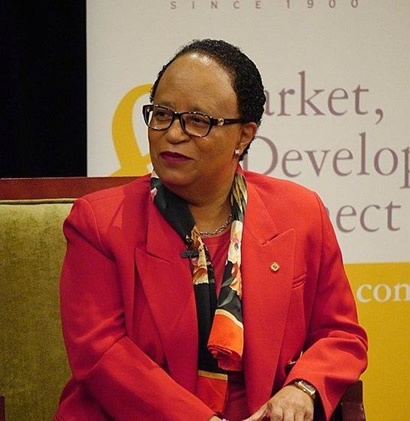Early Life
Shirley Ann Jackson is a prominent physicist and university president who was born on August 5, 1946, in Washington, D.C. to George Hiter Jackson and Beatrice Cosby Jackson. Growing up, her mother would read her the biography of Benjamin Banneker, an African American scientist and mathematician who helped build Washington, D.C., and her father encouraged her interest in science by assisting her with projects for school. The Space Race of the late-1950s would also have an impact on Jackson as a child, spurring her interest in a scientific investigation.
She attended Roosevelt High School in Washington, D.C., where she took accelerated math and science classes. Jackson graduated as valedictorian in 1964 and encouraged by the assistant principal for boys at her high school, she applied to the Massachusetts Institute of Technology (MIT). She was among the first African American students to attend MIT, and in her undergraduate class, she was one of only two women.
Her Early Academic Career
Shirley Jackson found strength in academic work and immersed herself in research, recording her equations in a large artist’s sketchbook that dwarfed the standard notebooks used by other theoretical physicists.
By 1973, she had completed a doctoral degree in particle physics, the first woman to receive a PhD in physics in MIT’s history. Her dissertation described a new way to model complex collisions. The thesis, titled ‘the Study of a Multi-peripheral Model with Continued Cross-Channel Unitarity’, under the supervision of James Young, the first African American tenured full professor in the physics department at MIT. In 1975, the thesis was published in Annals of Physics.
In 1974, after receiving her degree, Jackson was recruited as a research associate in theoretical physics at the Fermi National Accelerator Laboratory, or Fermilab. At Fermilab, she studied medium to large subatomic particles, specifically hadrons, a subatomic particle with a strong nuclear force. Throughout the 1970s, Jackson would work in this area on Landau theories of charge density waves in one- and two-dimensions, as well as Tang-Mills gauge theories and neutrino reactions. Shirley Jackson served as visiting science associate at the European Organization for Nuclear Research in Switzerland and worked on theories of strongly interacting elementary particles. In 1975, she returned to Fermilab and was simultaneously elected to the MIT Corporation’s Board of Trustees.
She became a member of the MIT Corporation in 1975 and is now a lifetime member. “I understood universities from the point of view of oversight and from the point of view of the faculty, in terms of how to organize research.”
In 1976, she accepted a position at Bell Laboratories in New Jersey, where she switched research areas and focused on the electronic properties of two-dimensional condensed matter systems. “Shirley was very intelligent mathematically and made the transition successfully to a new field, which is not something too many people do,” says Patrick Lee ’66, PhD ’70, a colleague at Bell Labs and now a professor of physics at MIT. “It gives you an idea of her flexibility and breadth of interest.”
While she was at Bell Labs, Shirley collaborated with Lee and others on research related to charge density waves, which describe how electrons organize themselves within layered crystals. The group was interested in how these electrons behave in areas where one layer of a crystal meets another. They focused in particular on how electrons cluster in repeated patterns, “with a particular kind of bunching effect,” as Lee puts it. They also modelled how these bunching patterns would change with variations in temperature—and how those changes would affect the properties of the material.
In 1991, she served as a professor at Rutgers while working for AT&T Bell Laboratories in Murray Hill, New Jersey. In 1995, she was appointed by President Clinton to the chair of the Nuclear Regulatory Commission. In 1997, she led the formation of the International Nuclear Regulators Association. In 1998, Shirley was inducted into the National Women’s Hall of Fame; the following year, she became the eighteenth president of Rensselaer Polytechnic Institute. She remains an advocate for women and minorities in the sciences and, since 2001, has brought needed attention to the “Quiet Crisis” of America’s predicted inability to innovate in the face of a looming scientific workforce shortage.
Recognition from President Clinton
Her great work did not go unnoticed. In 1994, she got a call from the White House; President Bill Clinton wanted her to serve as chair of the Nuclear Regulatory Commission. She accepted, even though it meant giving up her tenured position at Rutgers and spending the workweek away from her husband, physicist Morris Washington, and their son, Alan, who was just starting high school. As head of the NRC, Shirley developed and implemented regulation for assessing risk at the country’s nuclear power plants. Her approach took advantage of sophisticated computer modelling—much of it pioneered at MIT—to make probability-based judgments about the likelihood of various problems. For instance, if a power plant operator wanted to make physical changes to the plant or operate it differently, regulators could more accurately predict the relative risks of those changes. Victor McCree, who joined Jackson’s staff at the commission in 1996 and is currently its executive director for operations, says the new approach was “probably the most significant philosophical and practical change in the history of the NRC.”
Shirley also led international efforts to promote nuclear safety, working in places including post-apartheid South Africa and the countries of the former Soviet Union. “My first year as chairman, I went to Chernobyl and that focuses the attention.” Nearly a decade after the 1986 accident, the site still had high radiation levels emanating from the destroyed reactor and radioactive contamination in a broad area around the plant. She and her team “helped the Ukrainians figure out what to do and how to seal this thing up,” helping to train regulators and inspectors in the region. She also oversaw the creation of the International Nuclear Regulators Association, which supports nuclear regulation around the world.
Her Later Academic Career
Sequel to her stint at the NRC, she returned to academia in 1999 as president of Rensselaer Polytechnic Institute. As the sixth person to serve as president in 14 years, she aimed to transform RPI into a world-class technological research university. She was ready, having already served on the boards of Rutgers and MIT.
Her efforts to reshape the university met with relative difficulties. In 2006, she prevailed in a vote of no confidence by a small margin. She said the faculty was concerned about tighter criteria and higher expectations for promotion and tenure, among other things. In a separate struggle, her administration suspended the faculty senate in 2007. The Board of Trustees had asked the Senate to amend its constitution to limit its membership, resulting in an impasse; the Senate was then reconstituted in 2012.
 From 2009 to 2014, she served on the President’s Council of Advisors on Science and Technology (PCAST) for President Obama; in 2014 she became co-chair of the President’s Intelligence Advisory Board, serving until early 2017. In these positions, she led a study on advanced manufacturing in the United States and got involved with issues of national and global security, cyber-security, and digital technology.“She has a broad view of how science and technology can assist our country and the world,” says Gates, who served with Jackson on PCAST. In 2016, President Barack Obama gave her the ‘National Medal of Science’ award.
From 2009 to 2014, she served on the President’s Council of Advisors on Science and Technology (PCAST) for President Obama; in 2014 she became co-chair of the President’s Intelligence Advisory Board, serving until early 2017. In these positions, she led a study on advanced manufacturing in the United States and got involved with issues of national and global security, cyber-security, and digital technology.“She has a broad view of how science and technology can assist our country and the world,” says Gates, who served with Jackson on PCAST. In 2016, President Barack Obama gave her the ‘National Medal of Science’ award.
In 2017, Standard & Poor’s lowered the university’s long-term bond rating from A- to BBB+, citing its high debt burden and low level of available resources. But RPI maintains an A3 bond rating with Moody’s, and her plans to shore up the university’s finances with a capital campaign launched this past fall. The new campaign follows her successful Renaissance at Rensselaer campaign, which had risen to over $1 billion by 2008 in support of her vision for RPI, known as the Rensselaer Plan.
Shirley Ann Jackson was described as a ‘national treasure’ who defied a lot of odds to acquire all her achievements. She is a rare gem and will forever be remembered in the world of the scientific academy. She gave words of encouragement to students, including one who worried that maybe she was there because of affirmative action. “If you are here, a door opened for you,” she told the student, noting that doors open for many reasons. “What happens now is a function of what you do.”




